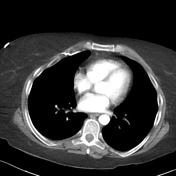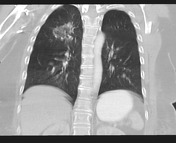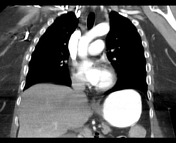Presentation
T-cell non-Hodgkin's lymphoma. Autograft recently - short duration neutropenia, but otherwise quite well.
Patient Data









Within the lungs there is patchy ground glass opacification within the right apex, left upper lobe anterior basal segment and right perihilar distribution with some very small foci of associated consolidation. The largest focus of opacity resides within the right apical lung and is in a reversed halo/atoll configuration.
No cavitation. No pleural or pericardial effusion. No axillary or mediastinal lymph node enlargement. Incidental note of variant aortic arch anatomy, with an aberrant retro-esophageal right subclavian artery. No suspicious bony abnormality seen.
There is apparent severe stenosis or occlusion of the right subclavian vein with extensive shoulder girdle and chest wall collaterals diverging flow to the superior vena cava.
Case Discussion
Cryptogenic organizing pneumonia (COP), either primary or secondary is considerably more likely than invasive fungal infection, due to the very short duration of neutropenia prior to radiologic abnormality, prior autograft rather than allograft (thus not graft versus host disease) and seeming lack of respiratory symptoms. The reverse halo sign (also known as the atoll sign) is typical of cryptogenic organizing pneumonia and seen more frequently than in invasive fungal infection. When seen in invasive fungal infection the reversed halo sign is said to be more suggestive of zygomycetes rather than invasive aspergillosis.




 Unable to process the form. Check for errors and try again.
Unable to process the form. Check for errors and try again.